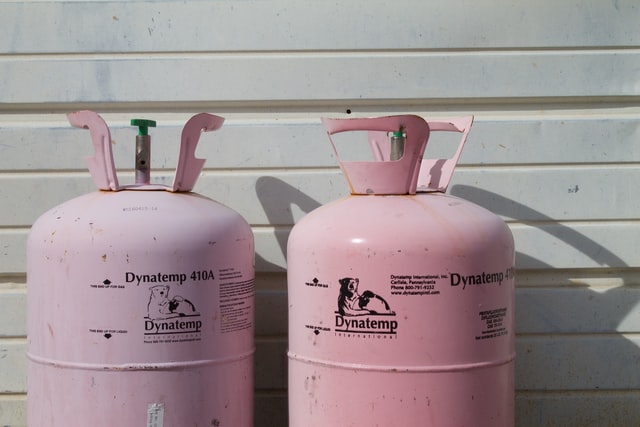
Heat Pump refrigerant choice isn’t something that gets talked about very often, because it is a somewhat arcane topic and normally left to the experts to decide which refrigerant to use.
However, did you know that some refrigerants are more environmentally friendly than others?
Beyond the environmental harm that certain refrigerants can cause, there are wider reasons you might want to avoid the use of particular types of refrigerant in your heat pump. It’s important therefore to know the basics before you make a decision on your heat pump system.
Heat pumps are a fantastic way to heat your home, providing reliable, eco-friendly warmth with far greater efficiency than many of the alternatives available on the market today. Despite previous environmental concerns associated with the refrigerants used in heat pumps, they are overall a good thing in terms of their impact on the environment, with much lower carbon emissions than traditional fossil fuel alternatives.
If you are considering installing a heat pump for environmental reasons, you are definitely on the right track. Providing you use a certified heat pump installer with training in the correct handling and use of refrigerants, installing a heat pump is an emphatic win for the environment.
Does a heat pump need refrigerant?
In short, yes, a heat pump needs refrigerant to be able to operate. Refrigerants are heat transfer fluids, which are essential to the operation of all heat pumps.
All heat pumps make use of the refrigeration cycle to collect heat from outside and distribute it around the building. The heat is collected and moved around the system using a refrigerant fluid, which has the necessary thermodynamic properties for optimal operation of the heat pump.
Heat pumps come in different varieties and are generally lumped together in categories depending on where they source their heat. The main types of heat pump are as follows.
You might come across other types of heat pumps in doing your research, perhaps you’ve heard of a hybrid heat pump system, which is just a heat pump combined with another form of heating.
Hybrid heat pump systems often make use of air source heat pumps with a backup fossil fuel boiler that kicks in under certain conditions, for example in very cold weather when a heat pump alone cannot provide sufficient heat efficiently.
All these different types of heat pump use refrigerant in their operation and cannot function without it.
What is the refrigeration cycle?
The refrigeration cycle describes the processes that take place in a heat pump system during the transfer of heat from outside the property to inside.
Electrical energy is used to achieve the transfer of heat and a typical heat pump will be able to transfer 3-4 units of heat energy for each unit of electrical energy consumed. This is what makes a heat pump so efficient and earns them a place in the category of renewable energy technologies.
In basic terms, heat is gathered from outside the building where the refrigerant evaporates in the heat exchange coils. The refrigerant fluid is then compressed, which concentrates the heat, before being passed through the condenser coils, which releases the collected heat into the building.
The refrigerant fluid next passes through an expansion valve before continuing its journey back to the evaporator the outside building, where it once again collects heat, and the cycle begins again.
So you see, refrigerant is an essential element needed by all heat pumps.
How often does a heat pump need refrigerant?
So now we know that heat pumps use the refrigeration cycle, and pump refrigerant around the system. The refrigerant is recycled around the heat pump, collecting heat outside the property and emitting it inside the living space.
Refrigerant is not consumed by the heat pump, so top ups should not be needed unless there is a leak in the system somewhere.
Heat pump refrigerant leak
Although it’s unlikely, your heat pump could develop a leak in the refrigerant line at some point and, if left unrepaired, this will eventually cause your unit to break down.
Any leak is best addressed quickly, before too much refrigerant escapes. Catching a leak early on will obviously prevent you from losing too much valuable refrigerant, which will cost you money to replace. It will also prevent potential damage to the environment.
Although regulations have been put in place in recent years to limit the use of the most environmentally damaging refrigerants, they are still not completely benign when it comes to global warming potential and care must be taken during their handling use.
Here are a few tell-tale signs that your heat pump has developed a leak.
Hissing noise
If there is a hissing noise coming from your heat pump, it’s likely that you have quite a serious leak, which requires immediate attention from a heat pump engineer.
High electricity bills
If your electricity bills gone through the roof, this might be because your heat pump decide to work extra hard to keep your house warm due to the loss of refrigerant.
Tepid or cool air coming from your unit’s vents
If is the air being blown from the indoor unit of your heat pump is insufficiently warm, or perhaps even cold, this is a clear indication pump is not operating optimally. This could be down to a lack of refrigerant.
Best refrigerant for heat pump
The best refrigerant for a heat pump is one that has the ideal properties for the job.
These properties relate to the impact of the refrigerant on the environment as well as its thermodynamic properties and cost.
Some important considerations include the following properties that should be demonstrated by a refrigerant for use in a heat pump.
- Low boiling point.
- Low cost.
- Ease of recycling.
- Stability under heat pump operating conditions.
- Low global warming potential (GWP).
- Zero Ozone depletion potential.
- Nonflammable.
- Non-toxic.
Refrigerant codes

To make sure everybody is clear about the refrigerant being used, each one has a specific code designated.
The codes begin with the letter ”R”, which stands for “refrigerant”, followed by a series of numbers that relate to the number of carbon, hydrogen and fluorine atoms each contains.
R400 series
The R400 series refrigerants do not have specified evaporation temperatures. Instead, their evaporation points are specified as a range. These are zoetrope mixtures.
R500 series
The R500 series all have fixed evaporation points. These are azeotrope mixtures.
R600 series
The R600 series are organic refrigerants.
R700 series
The R700 series are inorganic refrigerants.
Global warming potential (GWP)
One of the concerns surrounding refrigerants is their global warming potential (GWP).
GWP is a measure of the contribution a gas makes to global warming compared to carbon dioxide. It is expressed as a ratio, with 1 being the warming potential of CO2 itself.
Some of the older refrigerants used by industry has very high GWP, such as R-23 (Trifluoromethane / Fluoroform), which has a GWP of 14,800. This means that it contributes to global warming 14,800 times more strongly than CO2. Perhaps unsurprisingly, R-23 has now been banned for adding to systems of 40 carbon dioxide equivalent tonnes.
The rules around the use of different refrigerants are complex and beyond the scope of this article, but if you want to read more, check out the government guidance – Bans on F gas in new products and equipment: current and future.
Does R-22 cool better than 410A?
There are alternative refrigerants available with much lower GWP, such as R-410A, which has a GWP of 2,088 and has improved efficiency to boot. However, R-32, which has GWP of 675 is being used instead in some heat pumps, such as those being pioneered by brands like Daikin.
So, things are moving in the right direction as far as minimisation of the GWP of refrigerants is concerned, but continued pressure from regulation and consumers is needed for this to continue.
Refrigerants ozone depletion potential
In addition to contributing to global warming, many of the refrigerants on the market damage the ozone layer as well.
The ozone layer is a stratum of gas that occurs approximately 15-30km above the surface of the earth and provides a protective shield from the damaging effects of the sun’s rays.
Without it we can expect to see increased incidence of skin cancers, which is why the international community has put in place agreements for the reduction and phase down of these damaging substances.
CFCs and HCFCs were the most widely used refrigerants prior to the 1990s, but these gases were responsible for the depletion of the ozone layer.
The Montreal Protocol was an agreement reached in 1987 by the international community to regulate the production and consumption of almost 100 manufactured chemicals that contributed to the depletion of the ozone layer.
The Montreal Protocol set out the framework for the phase out of HCFCs and the phase down of HFCs. These and other measures are expected to see the ozone layer return to its previous condition and once again offer protection to those beneath from the sun’s rays.
Summary
There are a wider variety of heat pump refrigerants available. Many of these refrigerants are ozone depleting substances (ODS) and greenhouse gases (GHG).
As the heat transfer fluid for heat pumps, refrigerants are at the heart of heat pump performance. Their effectiveness and efficiency as heat transfer fluids must be balanced against their potential to harm the environment.
Overall, the operation of a heat pump is a huge net positive good for the environment due to its efficiency and reduced carbon emissions compared to fossil fuels, which over 80% of households in the UK still rely on for their heating.
Provided care is taken in the installation and maintenance of your heat pump, with qualified and licenced technicians carrying out the work, you can be assured you are taking the right decision for the environment by installing a heat pump.
If you enjoyed this article, why not take a look at our article on finding a qualified heat pump installer, with tips and advice on what to look out for to ensure the job is done properly.